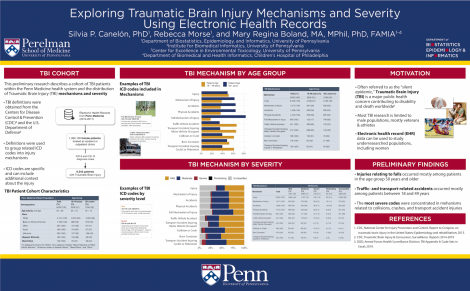Silvia Canelón
Exploring Traumatic Brain Injury Mechanisms and Severity Using Electronic Health Records
Abstract
Objective. Often referred to as the “silent epidemic,” Traumatic Brain Injury (TBI) is a public health concern contributing to disability and death worldwide. Our study describes a cohort of TBI patients within the PennMedicine health system and the distribution of TBI injury mechanisms and severity.
Methods. We obtained Electronic Health Record data for 1,060,100 female patients treated at PennMedicine inpatient or outpatient clinics from 2010-2017. We identified patients with TBI diagnoses using ICD-9/10 codes and the Disease Control and Prevention (CDC) and Department of Defense (DOD) definitions for TBI and TBI severity. The CDC/DOD codes for TBI were then manually annotated with mechanisms of TBI injury (e.g. Sport Mechanism of Injury, Collision or Crash, Foreign Body Object). The highest TBI severity category was noted for each patient and defined, in increasing severity, as “Mild,” “Moderate,” “Severe,” or “Penetrating.” We report the distribution of TBI mechanisms and severity among this patient population.
Results. There were 4,392 patients with a total of 9,800 TBI diagnoses. The majority of diagnoses in the cohort were Mild (5,704; 58%), followed by Moderate (3,840; 39%), Severe (173; 1.8%), and Penetrating (83; 0.8%). The following are the six most common mechanisms observed to contribute to TBI diagnoses: “Injury,” “Mechanism of Injury,” “Accidents,” “Physical Accidents,” “Fall Mechanism of Injury,” and “Traffic Vehicle Accident.”
Keywords
Electronic Health Records, EHR, data mining, traumatic brain injury, TBI, TBI mechanisms, TBI severityAbout Us
To understand health and disease today, we need new thinking and novel science —the kind we create when multiple disciplines work together from the ground up. That is why this department has put forward a bold vision in population-health science: a single academic home for biostatistics, epidemiology and informatics.
© 2023 Trustees of the University of Pennsylvania. All rights reserved.. | Disclaimer


